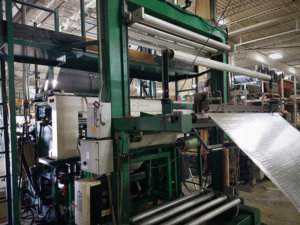Understanding Web Coating Machinery and Its Uses

Don’t worry—we have some tips for you. Whether you’re in the early planning stages, or you have substrates and coating materials chosen, CTI is ready to help you learn.
What is Web Coating?
Let’s delve into the process that requires web coating machinery in the first place. Web coating is a common manufacturing process, and it’s fairly wide-ranging. At its most basic level, web coating involves applying any number of specialized coatings onto different substrates and webs. What is a web, you ask? A web is most valued for its flexibility and stretchy qualities.
What are webs made of? It depends on why you need the web in the first place. Some of the most common web materials include paper, foil, plastic, film, metal, and wire. Industries that commonly utilize these web materials include:
- Photography. We can process film through web coating.
- The home improvement industry. Additionally, we can create materials like sandpaper, wall coverings, vinyl flooring, and coated vinyl with web coating machinery.
- Laminating. Whether we require the lamination for industrial or decorative purposes, we often produce it through web coating.
- Packaging. Manufacturers create the flexible packaging we use within a wide variety of industries with web coating manufacturing.
What makes web coating a bit more complex is the initial application of the required coating material. Typically, we apply the coating material to a flexible, moving substrate. We use a metering system to apply the right amount of coating material—it’s important that you avoid applying too much or too little. Therefore, you must be careful about the web coating machinery you work with, and ensure that it’s used correctly.
What is Web Coating Machinery?
When it comes to web coating, there is a specific type of machinery we must use. There’s a specific type of machine to keep in mind—a coater machine. We use this equipment in particular for the coating of film and paper, as well as other thin, web-like products.
Not only does a coater machine apply the coating to a substrate—it’s also responsible for dividing the substrate afterwards. The machine cuts the product into slices, or alternately rolls it after drying. Machines with multi-functional heads can also accomplish different types of coating. Some also speed up the winding aspect of the process by using a full-speed automatic film splicing mechanism.
Perhaps what’s most important with any kind of web coating machinery is consistency. There is no point in pursuing the coating process unless you’re assured of quality control. Fortunately, there are multiple coating processes for you to choose from. Among them is gravure coating.
What is Gravure Coating?
A more specific process you may want to consider is gravure coating. As previously mentioned, it’s important that we meter coating materials correctly before applying it to the substrate. Gravure coating finds a solution to potential errors by pre-metering the coating material. We reach this solution, in part, by using engraved rolls, sometimes referred to as gravures or applicator rolls.
Part of what makes gravure coating effective is the specific type of web coating machinery used in the process. The applicator rolls for gravure coating utilize ceramic or steel rollers—this makes engraving that much easier, and the application process that much more effective. Of course, we must transfer the coating material onto the roller before making any further moves. This is typically done either by rolling the roller in a pan full of coating material, or by completely submerging the roller in the coating material.
How Do We Ensure Accurate Gravure Coating?
One of the main reasons why coating processes can be subject to error is because of excess coating material. Excess coating material can cause engraved patterns to smudge or otherwise apply inaccurately. Additionally, the excess can cause the coating material to layer too thickly. This is why, with the gravure coating processes, one uses a knife to scrape off any excess before we apply the coating to the substrate. This blade component is a crucial part of web coating machinery when gravure coating is underway.
The roll continues to rotate, of course—from this point, the coating is applied to the web at a nip point, which is formed through the engraved roll and a backing roll covered in rubber. Both rolls move in the same direction and speed at this time, which ensures that the machine transfers coating to the web via nip force. We control the amount of coating transferred to the web with the size and shape of the cells.
However, this isn’t the only determining factor. Other factors include web properties, coating viscosity, the construction of the blade used, angle and pressure, rubber thickness, rubber hardness, and speed. One of the reasons why we utilize gravure coating so often in the manufacturing industry is because of these parameters. The strictness of these parameters, as it were, actually makes it easier for you to replicate the results of gravure coating. As long as you repeat these parameters, you can repeat the results.
Give CTI A Call
Curious about putting these processes into action? It might be easier to work with a third party that knows what they’re doing, and can deliver the consistent products you need. Contact CTI here or call us at 419-924-5566 to discuss your potential options, whether you’re interested in totally hands-off toll manufacturing or a more involved professional relationship.
- << < Previous Post
- 1
- 2
- ...
- 53
- ...
- 250
- 251 Next Post > >>

